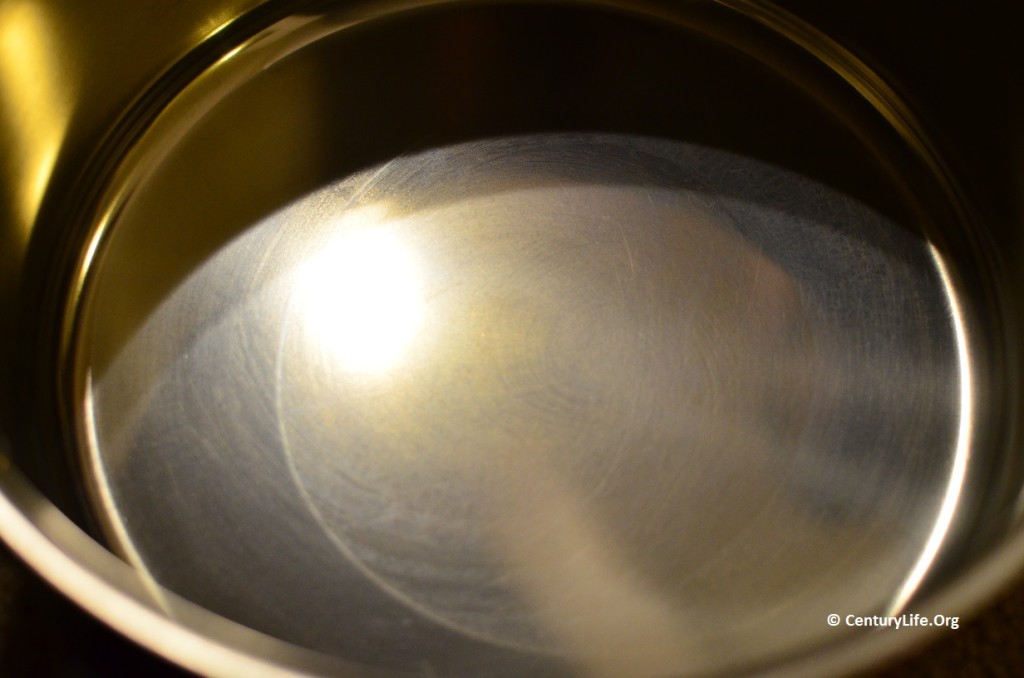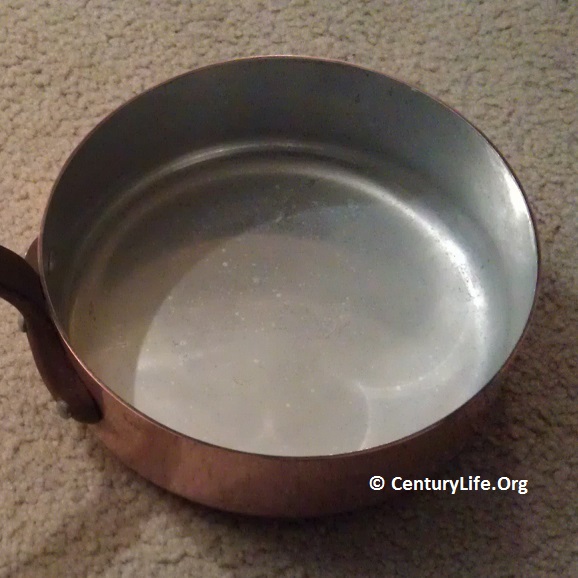Cooking surface: 2/5 Poor (fragile, low melting point)
Conductive layer: N/A (tin is never the main heat conductive layer)
External surface: N/A Poor (tin is too soft for exterior use)
Example: Mauviel
Health safety: 4/5 Good (tin is mostly but not totally non-reactive)
—–
DESCRIPTION AND COMPOSITION

Tin is an extremely soft metal that you can scratch with your fingernail.1 Tin transitions from shiny “beta” tetragonal tin to rhombic tin between 161C and 202.8C (321.8F and 397.04F).2 It’s still tin, just in a different crystal arrangement and slightly less shiny. Tin melts at 231.9C (449.42F).3
Tin is used in copper cookware as a lining because tin resists corrosion, is nontoxic, and is relatively non-reactive compared to bare copper. Ingesting large amounts of copper can lead to negative health consequences, so always have your tin-lined copper re-lined once you see large bare areas of copper peeking through.4
IS TIN TOXIC?
Tin is not toxic in small amounts, especially elemental tin, hence the proverbial “tin can” for food.5 Unless you plan to gnaw on your tin-lined cookware, it should not be a problem to absorb a milligram here or there from tin.
TIN-LINED COPPER VS STAINLESS-LINED COPPER
Frankly I would avoid both since copper cookware tends to sell for small fortunes, and you can get thick aluminum for much cheaper and at a lower weight and still get very good thermal conductivity.
But if you must have copper than stainless-lined is the way to go for most people. Here’s why:
Tin is fragile. You can think of tin as the world’s most fragile Teflon that isn’t even nonstick. Tin is so soft that a fingernail can scratch it. Even if you use wooden or nylon or silicone utensils, you might end up pushing a bone or something against the tin and scratching it. In contrast, stainless steel is fairly durable as long as you don’t abuse it with bleach or leave acidic foods sitting in it overnight or something.
Tin has a low melting point. If you’re human, you’re imperfect. And that means you might accidentally leave the pan on a little too long and melt your tin. One time is all it takes to do serious damage to a pan. Even if you somehow manage a perfect record of never overheating your pans, there is little room between frying temperatures and 450F, making for stressful heat management. And who needs more stress in his or her life? That said, tin’s melting point is less of an issue for cookware that will only be used for lower-temperature cooking such as boiling water, soup, and stews.
By the way, stainless steel has a melting point of over 2500F, making it virtually unmeltable in normal residential stovetop use.

Tin is not that nonstick. Tin is less sticky than stainless steel, but it is still stickier than well-seasoned cast iron or PTFE/Teflon. So if you want a fragile nonstick pan that can’t go over 450F, why not simply get a Teflon pan instead? Some manufacturers make very thick aluminum pans that rival the midrange copper pans for thermal conductivity; 4 mm of aluminum alloy rivals 2 mm of copper (depending on exact alloys in question). Ceramic pans are another alternative.
Furthermore, stainless steel may be sticky, but it’s not necessarily unusable. Preheating a pan to 400F, adding a little oil, adding food, letting food stick and then release on its own after a few minutes, is a tried and true formula. About the only things stainless can’t cook so easily are eggs and possibly some fish.
Tin’s thermal conductivity advantage over stainless steel is unimportant. Tin is on par with cast iron as far as thermal conductivity goes. Thus in theory tin-lined copper should be more responsive to thermal changes than stainless-lined copper.
But at the thicknesses that we’re discussing, does it matter? Thin layers of tin and stainless steel are unlikely to materially impact cookware responsiveness to heat. Also, even heating is also basically unaffected by using stainless steel over tin, because both are too thin to matter. For all copper cookware lined with stainless steel, the stainless steel lining is typically ~0.2 mm thick.
Furthermore, small changes in thermal responsiveness usually don’t matter. With tin, you might get to preheat your pan or boil water slightly faster, which is of dubious benefit. You might be able to lower heat faster too, but if you really wanted to drop heat quickly, you could just lift the pan up and put it on an unused burner.
Back to A No-Nonsense Guide to Cookware Materials.
FOOTNOTES